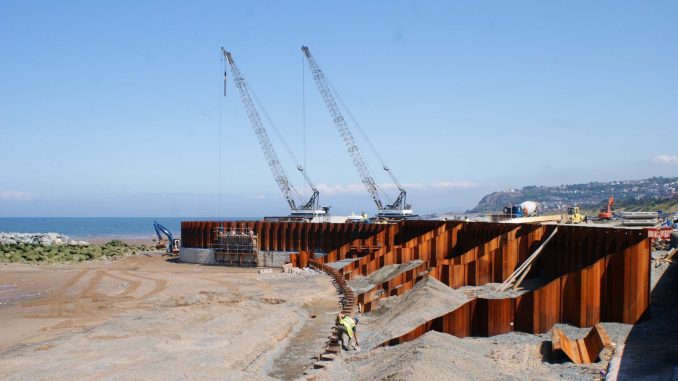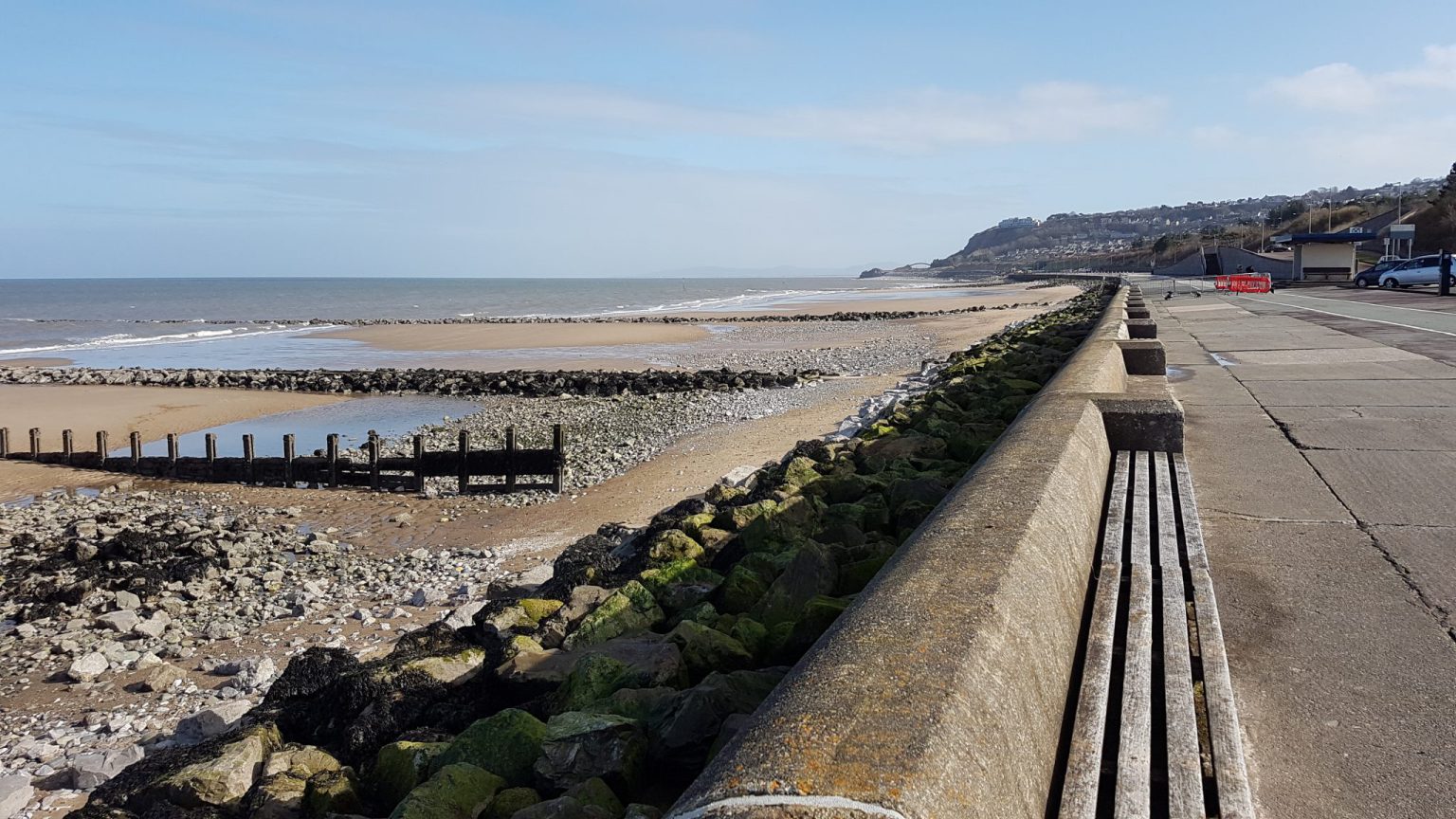Old Colwyn coastal defence gains CEEQUAL rating of Outstanding
Overview
The Colwyn Bay coastline in North Wales has been suffering from rapidly deteriorating coastal defences, with storm events resulting in lowering beach levels, frequent damage, promenade and highway closures and reactive emergency repair works. To combat this problem, Conwy County Borough Council conceived the Colwyn Bay Waterfront Project (CBWP) separated into three phases. The third of these phases is the Old Colwyn Coastal Defence and Active Travel Scheme. It received an Outstanding CEEQUAL (now known as BREEAM Infrastructure) rating in the Strategy and Design Award. |
About
This major scheme was delivered by Conwy County Borough Council.
Background
The scheme involves a permanent upgrade of the coastal defences to protect the Old Colwyn coastline from Splashpoint in the east to Porth Eirias in the west (1.2km). It also made improvements to the promenade to facilitate active travel and regeneration.
The coastal works design included a new rock revetment, outfall extensions and groynes, a new access build out, beach access steps, a fishing platform and promenade raising. Ecological enhancement measures, both marine and terrestrial, are also included as part of the scheme. The design also included promenade and active travel improvements, including:
Pedestrian and cycle path improvements
Pedestrian crossings and improved access to the promenade
A new picnic and outdoor education area
Promenade landscape improvements such as an activity zone, flexible open space, seating and artwork
Landscape planting
Parking improvements
Improved highway alignment and width
Furniture and lighting
A new concessions building.
Challenges
The design process fully embedded sustainable objectives from the beginning. Its aims were to:
Protect existing infrastructure of regional importance
Encourage active travel to improve health and wellbeing and to reduce motorised travel
Stimulate regeneration and boost tourism for Colwyn Bay
Provide ecological enhancements
Account for climate change within the design
Produce an inclusive design fitting within the context of the local area and improving resource efficiency.
The scheme represented an opportunity to build on the success of previous phases of the CBWP with the production of a sustainable design that will allow the local environment and communities to thrive and grow.
The client embedded CEEQUAL into the delivery of the scheme. Coastal, structural, environmental and highways teams worked collaboratively to ensure consideration and implementation of sustainable solutions. The team undertook a Design for Resource Efficiency workshop (an internal tool) and ensured the environment was at the forefront to mitigate adverse effects and to provide enhancements to the marine environment, people and communities.
Design
The existing site is narrow and linear in nature, with varying ground levels and tight space constraints given the close proximity of the sea, existing railway, large existing sewers, existing highway, services and seawalls in poor condition, all of which presented a challenge for the design. Surveys were undertaken to determine existing geometry to help avoid clashes, raising and realignment of the road helped to alleviate the space constraints and the proposed revetement helped stabilise and protect the existing seawall. In addition, overtopping analysis helped to define and optimise the crest levels and protection philosophy.
Marine ecology enhancements
The Old Colwyn coastline represents a high energy environment, and thus limited options for marine enhancement measures. Discussions between the project team coastal engineers and marine ecologists developed ideas for enhancing hard engineering features, and ensuring a balance was maintained between ensuring the hard engineering solutions were not impeded whilst also ensuring the measures will be enough to encourage colonisation of marine organisms, such as the drilling of holes to provide complexities in the surface suitable for marine life colonisation.
Covid-19 limitations
Due to the government restrictions in place relating to Covid-19, some site survey visits (required to inform the environmental impact assessment) from March 2020 onward were suspended. To overcome these restrictions and ensure the EIA was still as robust as possible, novel ways of working had to be developed. For example, some assessments were undertaken by specialists using detailed photographic surveys completed by an experienced local environmental consultant. Subsequent interpretation was completed by experienced environmental specialists combining the photographic information with existing information and professional judgement and experience. Outcomes were interpreted on a precautionary basis where relevant.
Covid-19 also resulted in non-normal conditions during the planned baseline traffic and noise assessment period meaning these surveys could not be completed. Therefore alternative approaches were agreed with the Conwy County Borough Council Principal Environment Officer for the air quality assessment and with the Conwy County Borough Council Environmental Health Officer for the noise assessment.

Solutions
The project was developed with the aim right from the start to ensure that physical resources were used in the most efficient way in the design and construction process. Design for Resource Efficiency (D4RE), a tool developed by Mott MacDonald, was used at the outset of the design process, focusing the project team on aspects such as energy reduction, water reduction, and sustainable procurement, both during construction and operation.
The opportunities identified were implemented into the project where feasible, and resulted in approximately 32% reduction in carbon between the preliminary design and the tender design with a further 8% of identified savings to be potentially fully incorporated through detailed design and construction. Measures resulting in these reductions included reduction of piers from three to one, reuse of existing rock armour in the rock revetment and the use of rock rather than precast concrete.
The environment and design teams worked closely to achieve optimum ecological enhancement beyond functional requirements. This was achieved by enhancing the rock revetment, sea wall, existing groyne and outfall areas to make the surface more suitable for colonisation by marine life. This, together with provision of vertipools, interlocking tidal pools and wildflower planting, enabled biodiversity net gain.

Resilience
Climate change was considered as part of the design. The calculations used took into account climate change over the next 50 and 100 years, particularly variations in sea level over this period. This informed the optimisation of the revetment levels to ensure the design will be functional for the design life whilst also ensuring no unnecessary waste of resources by designing above the necessary requirements.
Transport
The project objectives included costal protection for key regional infrastructure including the existing North Wales mainline railway, the promenade highway and the A55 expressway behind the existing railway embankment. The project was also designed extensively to promote active travel, including improvements to the North Wales Cycle route network and pedestrian provision along the promenade.
Land use and ecology
Another important consideration was biodiversity. The coastal defence improvements as part of the scheme meant the loss of areas of intertidal habitat with few options for creating additional compensatory habitat elsewhere. The ecological enhancement sections of CEEQUAL drove the team to integrate ecological enhancement into the scheme design. Ecological enhancement opportunities were therefore discussed at a workshop early in the design process, with the ambition to go beyond the required mitigation to reduce the negative effects of the scheme.
To bring about benefits to the marine ecological environment, the design included rocky shore habitat creation by enhancing the rock revetment, sea wall and existing groyne and outfall areas to provide complexities in the surface suitable for marine life colonisation. To further benefit the intertidal ecology, vertipools and interlocking tidal pools have also been included within the design. These enhancements and the provision of wildflower planting have resulted in an anticipated biodiversity net gain.
Following a plastic survey completed along the beach and the discovery of a range of plastics present, the potential for the education of the public about the dangers of marine plastics pose was identified. The beach area will be classed (via signage and the appropriate placement of bins) as a single use plastic free zone.
Resources
In order to ensure the scheme considered resource efficiency from the outset of the design, the project team undertook a D4RE workshop. This workshop generated a number of ideas and suggestions as to how the scheme could reduce its use of resources and therefore realise carbon savings; measures that were implemented as part of the scheme include the reuse of existing rock armour, raising only the promenade and not the road too (at some locations) and re-use the existing wave return wall within the scheme design, as well as several other measures.
A carbon management plan was produced building on the ideas generated from the D4RE workshop, which included the target requirements, the approach to reducing carbon through design, ideas for carbon reduction through construction, calculations of carbon footprint for design stages and quantification of carbon reduction. The carbon assessment completed for the EIA determined there had been a 32% reduction in carbon between the concept design and the tender design with a further 8% of identified savings to be potentially fully incorporated through detailed design and construction. Measures resulting in these reductions included reduction of fishing platforms from three to one, reuse of existing rock armour in the rock revetment and the use of rock rather than precast concrete.
Communities and stakeholders
To encourage active travel, the design incorporated widening of the shared use footpath and cycleway fully segregated from the road, with significant improvements to National Cycle Route 5. Greater active travel will increase health and wellbeing along with decreasing the use of motorised vehicles and associated emissions.
Further wider benefits of the scheme from a sustainability perspective include the provision of Equality Act compliant ramped access to the beach, provision of an outdoor classroom area in landscaped gardens, activity travel health markers and interpretation panels highlighting the heritage of the area. The combination of all the aspects of the design and those measures beyond business as usual is anticipated to revitalise the promenade and the area of Colwyn bay to encourage tourism which the area heavily relies upon for income.
Benefits
Conwy County Borough Council have undertaken a CEEQUAL assessment on all previous phases of the Colwyn Bay Waterfront Project; each time, the project team have taken the opportunity to improve sustainable performance of the next phase by learning from best practice developed from previous CEEQUAL assessments and further realising innovative opportunities which ultimately have resulted in improved CEEQUAL scores each time. The benefits achieved through implementing CEEQUAL on all phases of the Colwyn Bay Waterfront Project have enabled better scheme publicity. The continued implementation of the CEEQUAL assessment throughout each phase of the project has facilitated a drive to maximise the environmental performance of the scheme. Continual improvement has been attained at each stage, and CEEQUAL has been a driving factor behind this.
Considered from the start
CEEQUAL was embedded into the scheme from the outset. CCBC, the client, is familiar with CEEQUAL and the requirements at strategy stage and endeavoured to further build on the CEEQUAL requirements at this stage to ensure the promotion of a sustainable scheme and developing scheme objectives that had to be considered at the design stage. The design team were also fully engaged with the CEEQUAL process, meaning that CEEQUAL drove more focus on enhancement opportunities, such as ecological enhancement, beyond functional requirements of the scheme.
Implementation using CEEQUAL
The implementation of CEEQUAL throughout this project has facilitated a drive to maximise environmental performance and achieve continual improvement. It has also enabled better scheme publicity, by allowing the communication of these achievements.
Financially, the CEEQUAL process helped reduced material quantities and helped promote opportunities for recycling and reused of site won materials, which will translate to lower construction costs. It also helped attract potential funding for the project due to its measured sustainable credentials.
Metrics
32% reduction achieved in embodied carbon emissions
37,689 tonnes of re-used materials utilised for this project
504 tonnes of recycled materials utilised for this project

Summary
Sophie Bennett, Mott MacDonald
